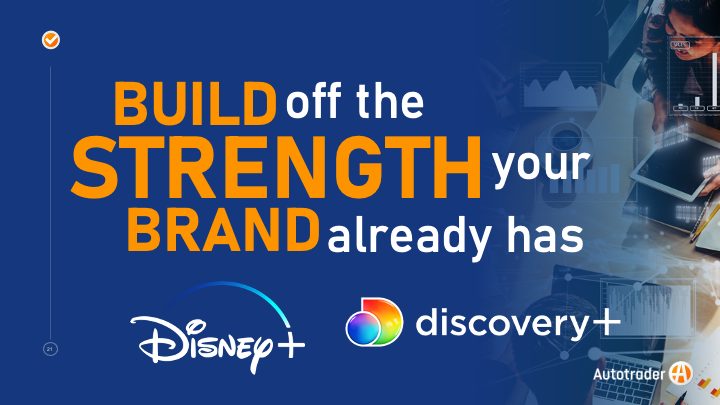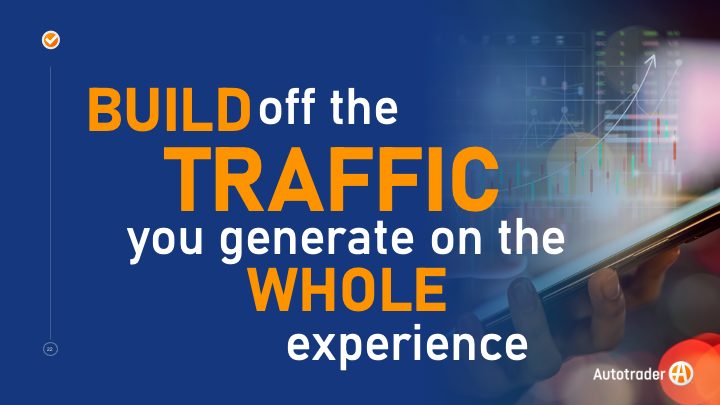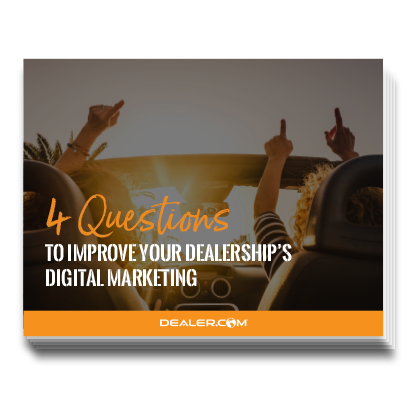
Everyone in the auto industry knows that the past year presented several hurdles for auto dealers to jump over, one after another. Inventory was low, buyer behaviors and our industry were still rapidly shifting, and the world was dealing with some pretty big macro-economic challenges.
In order to continue to drive profits and growth, even with all of the recent twists and turns, today’s successful dealers have learned that it’s time to leverage the brand you’ve already worked hard to build, the traffic you already have, and the reputation you’ve created in your community, state and possibly nationwide.
How can you take a fresh approach to maximize what you’ve worked hard for not just over the last few years, but for as long as your business has been in business? By getting back to the foundational elements we’ve outlined in the 4 ways below to help you expand your business and drive more sales in the coming year.

Build off your existing brand strength
Many dealers think that in order to stand out to their ideal customer, especially in a heavily online digital world, they need to make or create a new brand – specifically when it comes to eCommerce.
But they don’t… And you don’t have to!
The more that you can leverage the strength
of what you’ve been doing for years –
the more you have a chance for success in connecting
with your ideal customer and driving sales.
Did you know, on average it takes 2 – 5 years to establish a business and branding according to Forbes, and the cost can be anywhere from $40,000 to $500,000 depending on your brand and the upfront costs you will have? And that’s just typically the sticker price in the first year.
So instead of spending that money to build a “new” brand, why not build the brand you already have?
Examples of this would be Disney + or Discovery +. Both kept the brand, kept the name, kept the recognition, kept the strength and offered an ecommerce product. There is strength in your brand – you’ve spent a lot of time and money on your brand – the key is to modernize it.

Build off the traffic you drive from the whole experience
Next let’s look at the traffic you already generate…
Website Traffic: You already have a website, there is no need to scrap it and build an entirely new one. The key to modernizing it is to make it more robust!
Things like UI and UX design for ease of use and user functionality, SEO optimization, CRM / database integrations and solutions, chat bots or AI assistant automations, and easy to search and find inventory with updated, comprehensive and transparent vehicle listings… And the list goes on!
Start the year off right by taking a 360 degree look at how you can modernize and maximize your existing website and traffic.
Local Traffic: You have spent ad dollars over the years to generate traffic to your business and to be recognized within your community. Whether you’ve been in business for just a short while, or for decades, it’s important to capitalize on that traffic as well.
Chances are, you are most likely well known in your community and region as the “local” dealership. You’ve invested in and sponsored everything from print and web ads, radio spots, little league teams, fundraisers, and so on over the years within your community. And with that recognition you have, it can drive even more traffic.
Optimize and build a modern strategy around your community traffic and look at how you are positioning yourself both in your showroom and service center as well as online as your community go-to.
By building off the website and local traffic you’ve built since your dealership first opened its doors and first used your website to drive business, you’ve already paved the way for giving the consumer the whole experience.
The Whole Experience: What do we mean by whole experience? We mean that even before car shoppers step foot in your dealership, they know what your brand stands for and they know what kind of experience they can expect to have by doing business with you. This not only will lead to higher consumer satisfaction, but also increased traffic and sales.
In order to drive traffic and bridge a seamless experience both online and in-person, be sure to ask yourself the following questions and make sure you have a plan aligned within your dealership for each car shopper you connect with:
– Did you make the online / ecommerce experience easy for them?
– Were you transparent in your current offerings for new and/or used as well as sale and service specials or incentives?
– Did you stay in front of them with personalized content based on what they showed you online they wanted and preferred?
– Did you make it easy for them to find you, connect with you, and know what steps to take next?
– Did you make it clear why they should do, or continue to do, business with you?
– Once they showed up, did you show that based on data from their online research or interactions captured, you knew what their preferences were?
– Do you offer them something they can’t get somewhere else, and is that differentiator clear to them?
– Did you save them time and truly understand and shape their buying experience around what they wanted and preferred?
– Do you make the experience you offer a notch above any competitors, so that they wanted to not only buy or service a car, but to only do business with you both now and in the future?
As you see, it’s important to take another look at the traffic you’re already driving and build off of those foundational elements it in order to drive sales. Look for new ways to give potential and existing customers an experience online, as well as in person. And by optimizing and modernizing what you have worked hard to already build, you ensure a more seamless whole experience we know today’s car buyer is looking for.

Build off the reputation you’ve worked hard to establish and protect
Most dealerships not only work hard to establish a reputation, but also spend countless hours protecting it. And when you have a mapped out digital retailing and eCommerce strategy in play, it can help you build off that reputation and both protect and preserve it as well.
With digital retailing tools you have the ability to stay in front of and alongside your ideal customer and existing customers. You can show and remind them why they should do business with you, or why they should still do business with you. You can show what makes your auto dealership stand apart to give better service and put their best interests first. You can show them why you have the reputation you are known for.
By getting your operations in line and building a strategy from the top down on what your brand reputation stands for, you’ll have the ability to let that shine through online in your eCommerce marketing digital retailing efforts. When you do this, you’ve just leveraged a winning formula for building off of your hard earned and preserved reputation.
Especially if that unified messaging and experience extends to when they first walk on your lot. The pre-existing or perceived reputation, combined with their online and in-person experience, builds and adds to your reputation, as well as your profits when they are the same.

Build a brand between sales, service and operations
By focusing on getting your dealership in-line from the top down, you’ll enable your sales – service – and operations to work in sync towards a unified goal.
That goal should include what your brand stands for and how each department works alongside and with each other to drive sales and repeat business. This may seem obvious, but it often gets overlooked. There’s a big difference between only addressing it when reacting to a situation that could affect your brand negatively vs. being pro-active to build.
When you connect all of the departments on over-arching goals, you’ll also have the opportunity to optimize your existing digital retailing and eCommerce abilities, online paperwork, test drives, and delivery. Everything that goes into a sale, gaining or retaining a customer, or winning back a previously defecting customer. When these dots are connected for everyone at the dealership, it ultimately helps your brand stand out as the one to use.
Remember the more you offer, the more you educate, the more unified you are in your dealership experience and brand, the more you can make deals happen earlier in the car purchasing funnel.
Your dealership should also decide what you can do beyond the purchase in order to drive loyalty. Truthfully look at how you differentiate yourself from your competitors in terms of what you do and offer, items such as warranty and service and your unique offerings. Make sure everyone at your dealership knows what those differentiators are and include them in your eCommerce strategy core messaging to help your brand stand out.
You should also take the time to honestly think about and assess how your staff from each department are trained and informed / updated on your current marketing strategy and goals. By doing this on a regular basis, your in-store experience has a greater possibility of matching your online experience, and customer satisfaction and sales will benefit.
If that doesn’t match, the customer is not likely going to be happy. And your brand will suffer, as discord and disconnect will be felt. You don’t want to lose the chance you worked hard for.
A good place to start with your teams is with education and training on current and trending customer shopping behaviors and expectations, as well as ensuring the experience you gave online is the same experience a consumer receives in person as well, if not better.
When you make sure your sales – service – and operations are all leveraging your brand, traffic and reputation in your online digital retailing and eCommerce marketing strategy, and map out how that bridges into your dealership, you’ll not only drive more quality leads, but you’ll close more deals.
For the road forward
In this transformed automotive industry world, Cox Automotive truly has the complete tech stack you need based on where your dealership and brand are both at and headed without the overwhelm. Whatever your goals, we can help you get there faster and to stay a step ahead and successful in today’s marketplace.
Autotrader provides you with qualified leads for people that want cars. We have the data, and we have the shoppers. We know what they want, and our goal is to match them with our dealer partners. Because in today’s times, a trusted partner like Cox Automotive can help your brand stand out to your ideal customers.
Autotrader not only drives quality leads but delivers a 35% higher gross profit on average. We connect you with customers virtually, to move shoppers to you, so that you can focus on building and letting your brand shine.
All of us at Cox Automotive are here to not only here to help you succeed, but we’re here to help you for the drive forward, especially when it comes to developing your winning marketing strategy in the coming year. We invite you to connect with us to take a deeper look into ways to capture, connect and activate your data to make it more efficient and effective to drive both leads and business, to help you build upon what you have already worked hard to build.














